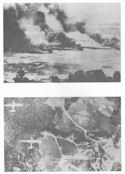
St. Mathias Islands--EMIRAU
LANDING ON EMIRAU UNOPPOSED
On 20 March, 1944 a landing force composed of the 4th
Marines landed on Emirau Island, the second largest of the St. Mathias group.
They encountered no enemy opposition and after the landing it was possible to
begin the construction of airfields from which Truk and the central Carolines
could be attacked. With the capture of Emirau the enemy's bases at Kavieng and
Rabaul were completely surrounded. Emirau Island is 75 miles northwest of
Kavieng and 15 miles southeast of Mussau, the largest of the St. Mathias group.
The Attack Group, was composed of one APA, the Coast Guard manned Callaway, 3
LSD's, 9 APD's, 2 AT's, and 9 destroyers. It departed Guadalcanal in two
sections on 17 March and effected a rendezvous at sea on the 19th. The Group
arrived at the Transport Area at 0605 on the 20th. As no opposition on shore was
anticipated, no preliminary bombardment, bombing or straffing was scheduled, but
the cruisers in the supporting Task Force were in position to deliver supporting
fire on call. The 66 LVT's were launched from the Gunnston Hall (LSD), and 2
assault battalions embarked in the APD's were transferred to them. The Callaway
then debarked its Reserve Battalion in its own boats for landing on call. The
landing on Beach
Green, was over a coral reef 50-100 feet wide, but no
difficulty was encountered by the LVT's. Beach Bed landing was on sand. Landing
of supplies and equipment commenced about 1100. The Callaway carried 789 tons of
cargo and had discharged all but 30 tons of this prior to 1930. Total personnel
landed was 3,727. At 1930 the entire Group withdrew to return to Guadalcanal. No
enemy contact, - air, surface, underwater, or ground - was made during the
entire period. No lives were lost. From 20 March to 8 April, 1944 five more
echelons delivered troops, supplies, and equipment to Emirau and the 147th U.S.
Army Infantry Regiment relieved the 4th Marines to become the permanent garrison
of the island.
COAST GUARD AT EMIRAU
Manning the Callaway (APA-35), the largest and only
conventional type assault transport employed in the operation, the Coast
Guardsmen put ashore the majority of men and equipment used in the landing.
Within an hour of landing on the southern shore of two beachheads on either side
of Eleona Village, hard-working Navy Seabees were blasting stump and clearing
brush for an airfield. Bombers and fighting planes continuously pounded enemy
airfields in the Kavieng area and at Rabaul, while several enemy submarines,
reported to be operating in the area, were kept at bay by a ring of fighting
ships. For more than 72 hours the APA Callaway, Captain D.C. McNeil, USCG,
Commanding Officer, was in an area alive with Japanese submarines and planes, a
large and tempting target with her huge cargo of precious lives, munitions, and
war machines. A few minutes after the first wave was loaded into small boats and
approached the beach, a chatter of machine gun fire broke out. It seemed to come
from the tiny islet of Elomusao, a few hundred yards off the beach, but all the
firing was from our side, owing to a suspicion that the enemy was lying in
ambush there. This proved to be untrue. The landing on Emirau was said to have
accomplished as much as a direct assault on Kavieng or Rabaul and it saved many
American lives.

